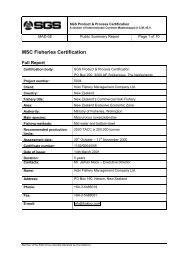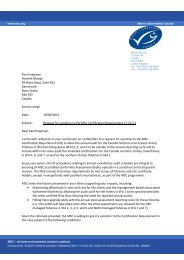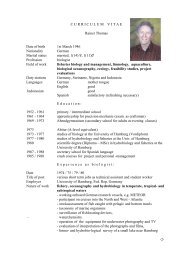SGS Product & Process Certification - Marine Stewardship Council
SGS Product & Process Certification - Marine Stewardship Council
SGS Product & Process Certification - Marine Stewardship Council
Create successful ePaper yourself
Turn your PDF publications into a flip-book with our unique Google optimized e-Paper software.
certified as sustainable on 3 rd December 2007 and essentially catches sea bass from the same<br />
stock unit exploited by the VBHL fleet. It has been subject to three annual surveillance reports.<br />
Another sea bass fishery, utilizing trawls in the Bristol Channel, has also been subject to MSC<br />
assessment (the draft report is available at http://www.msc.org/track-a-fishery/inassessment/north-east-atlantic/Bristol-Channel-sea-bass/assessment-downloads),<br />
but<br />
certification has not been recommended. In that case, the RBF was used and gave low scores<br />
that reflected concerns about the effect of fishing on the target species‘ population structure<br />
and its stock status (local depletion was clearly illustrated by data provided by stakeholders),<br />
and also the lack of positive management measures to minimise discards of both bass and by<br />
catch species.<br />
The quality of information on these fisheries and the scientific basis for assessment of sea bass<br />
stock status are similar, and therefore of relevance.<br />
9. OBSERVATIONS AND SCORING<br />
9.1 Introduction to scoring methodology<br />
The MSC Principles and Criteria set out the requirements of a certified fishery. These<br />
Principles and Criteria have been developed into a standard (Fishery Assessment<br />
Methodology) assessment tree - Performance Indicators and Scoring Guideposts - by the<br />
MSC, which is used in this assessment.<br />
The Performance Indicators (PIs) are presented on the MSC website. In order to make the<br />
assessment process as clear and transparent as possible, each PI has three associated<br />
Scoring Guideposts (SG) which identify the level of performance necessary to achieve scores<br />
100, 80, or 60 for each Performance Indicator: 100 represents a theoretically ideal level of<br />
performance; 80 a pass; and 60 a measurable shortfall.<br />
For each Performance Indicator, the performance of the fishery is assessed as a ‗score‘. In<br />
order for the fishery to achieve certification, an overall weighted average score of 80 is<br />
necessary for each of the three Principles, and no Indicator should score less than 60. It is not<br />
considered possible to allocate precise scores, and a scoring interval of five is used in<br />
evaluations. As this represents a relatively crude level of scoring, average scores for each<br />
Principle are rounded to the nearest whole number.<br />
Weights and scores for the UoC are presented in the scoring table (Appendix A).<br />
9.2 Risk Based Framework (RBF)<br />
9.2.1 Introduction to RBF<br />
The MSC assessment process is evidence based, in that it seeks to use published (i.e. peer<br />
reviewed) scientific information on stock status of target and by catch species and<br />
environmental impacts of the fishery wherever possible. Where scientific information is lacking,<br />
the MSC have introduced an alternative mechanism by which fisheries can be certified: the<br />
Risk-Based Framework (RBF). This scoring method allows stakeholder knowledge and expert<br />
opinion to be taken into account in data-deficient situations, particularly for the ―outcome‖<br />
performance indicators (PIs) associated with Principles 1 and 2.<br />
Page 38 of 151





